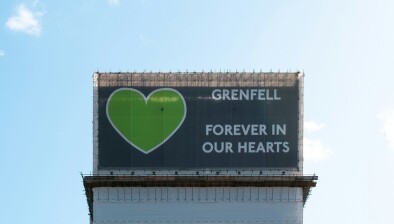Building and fire safety checks to step up as Grenfell cladding found in Scottish schools

The group established to oversee a review of building and fire safety regulatory frameworks on domestic high rises following the tragic Grenfell Tower fire in London has agreed to open consultations on further building standards.
Meeting for the third time yesterday, the Ministerial Working Group was updated on the latest actions being taken by the Scottish Government, local authorities, the fire and rescue service as well as other building owners across the country.
Although the group heard that no high rise domestic buildings owned by councils or housing associations have used the type of aluminium composite material (ACM) cladding reported to have been used on the Grenfell Tower, it emerged that the cladding has been found on a small number of low-rise schools in 14 Scottish council areas.
The group also discussed its work plan including establishing a Scottish Government Building Standards Working Group to work with international experts on a review of building standards.
It was agreed that the next meeting of the group on August 9 would include an in depth session to review evidence on automatic fire suppression systems including sprinklers. Ongoing communication will continue with stakeholders and various organisations, with the initial priority being to meet with tenants representatives over the summer.
A consultation will also take place in the autumn on common standards for smoke and fire alarms in housing bringing forward planned work.
The group noted the positive discussions which have initially been held with key partners in representing social landlords and local government. Thirty of the 32 local authorities have reported that ACM cladding has not been used on any privately owned high-rise domestic buildings. Edinburgh and Glasgow are completing their investigations and it was acknowledged this will take time due to the numbers involved. Scottish Government officials are in close contact with both local authorities and have offered additional assistance if required.
The Scottish Government has also requested information regarding universities and colleges including student accommodation. Initial indications are that there are no further issues expected.
All Scottish health boards have confirmed that none of their buildings use the cladding type reported to have been used on Grenfell Tower.
However, additional checks have shown that eight sites on the NHS estate - including Queen Elizabeth University Hospital (QEUH) in Glasgow - have used solid aluminium with A1 non-combustible fire rating material and mineral wool insulation.
NHS Greater Glasgow and Clyde has, however, been assured by Multiplex, the main contractor for the hospital construction, that the insulation material used in QEUH - Kingspan Kooltherm K15 Insulation Boards - were properly installed to meet building and fire safety regulations.
The meeting was chaired by communities secretary Angela Constance with housing minister Kevin Stewart and they were joined by Scottish Government officials and the Scottish Fire and Rescue Service.
Ms Constance said: “The group met today to continue our thorough review of our regulations and take any action needed - both immediate and longer-term - to ensure the highest standards of building and fire safety is in place across Scotland.
“While we continue to be confident that we have stringent building and fire safety regulations, we cannot afford to be in any way complacent. That is why our work programme is evidence-led and our focus is prioritised.
“Checks continue across Scotland by both local authorities and the fire brigade to assess buildings and reassure people that adequate fire protection measures are in place.”
The Scottish Government reiterated that building standards systems and regulations for high-rise domestic properties in Scotland means the type of product used on Grenfell Tower should not be used in their cladding systems.
However, in some controlled circumstances specified by Scottish building regulations, ACM can be used as part of the cladding systems of other buildings.
Scotland’s building regulations specify that those cladding systems must meet the relevant technical requirements applicable in each case.








